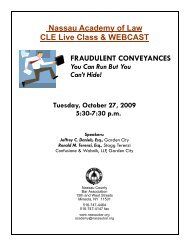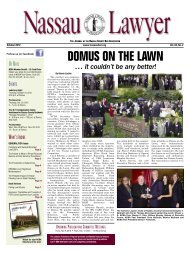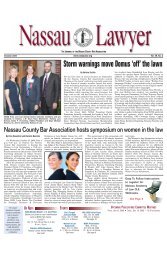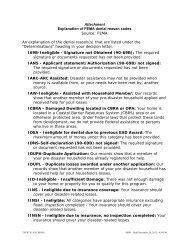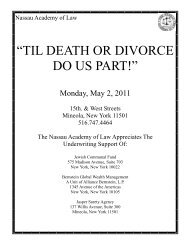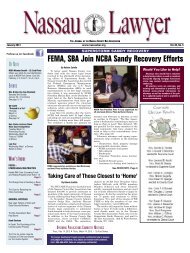COVER NL 09_06.qxd - Nassau County Bar Association
COVER NL 09_06.qxd - Nassau County Bar Association
COVER NL 09_06.qxd - Nassau County Bar Association
You also want an ePaper? Increase the reach of your titles
YUMPU automatically turns print PDFs into web optimized ePapers that Google loves.
18 n July/August 2012 n <strong>Nassau</strong> Lawyer<br />
WRONGFUL DEATH ...<br />
Continued From Page 3<br />
gives the plaintiff a windfall, which<br />
Milbrandt prohibits. 14<br />
The Appellate Division affirmed the<br />
judgment, as did the Court of Appeals.<br />
Article 50–B delays payment of damages,<br />
the court held, but not liability itself.<br />
Adding interest from when liability<br />
accrued, therefore, was not a windfall. 15<br />
Milbrandt and Rohring confirm the<br />
procedure as laid out in the statutes. If<br />
the verdict awards the full value of future<br />
damages, the judgment should discount<br />
that award to the date of liability, i.e., the<br />
date of death, and add interest up to the<br />
date of judgment. In Toledo, however,<br />
this procedure did not prove so simple to<br />
follow.<br />
Toledo: Restating the Rule,<br />
then Ignoring It<br />
In Toledo the decedent’s estate sued<br />
for negligence and wrongful death over a<br />
construction accident. The plaintiff won<br />
summary judgment in August 2006, and<br />
after a jury trial in December 2007 won a<br />
verdict that included future damages.<br />
The parties then submitted proposed<br />
judgments, neither of which followed the<br />
statutes or precedent.<br />
The plaintiff at first discounted future<br />
damages from the date of judgment to<br />
the date of verdict. Then the plaintiff discounted<br />
again, to the date of death. Then<br />
the plaintiff calculated interest from date<br />
of death to the verdict. Then the plaintiff<br />
added that interest to the award as discounted<br />
to the verdict. Further, the plaintiff<br />
discounted at a rate of roughly 4.33%<br />
but then calculated interest at the statutory<br />
rate of 9%. 16<br />
The defendant, on the other hand, neither<br />
discounted the award nor included<br />
any preverdict interest. The trial court<br />
adopted the plaintiff’s proposed judgment.<br />
The defendant appealed, but on<br />
appeal the parties entered into an unusual<br />
stipulation:<br />
The sole issue to be presented on this<br />
appeal is the question whether the<br />
trial court properly discounted the<br />
future wrongful death damages back<br />
to the date of death, and awarded<br />
interest thereon from the date of death<br />
to the date of judgment.<br />
The Appellate Division affirmed, relying<br />
on Milbrandt and Rohring. 17 The<br />
Court of Appeals also affirmed, restating<br />
the rule:<br />
We now conclude that the proper<br />
method for calculating preverdict<br />
interest in a wrongful death action is<br />
DEBT ...<br />
Continued From Page 9<br />
mary purpose of suing on them, in order to make a<br />
windfall. This ancient doctrine of “champerty” is<br />
provided for in Judiciary Law Section 489. 12 It<br />
implies that an assignee acquiring a claim must<br />
make some reasonable attempt to try and collect on<br />
it by legal means before commencing a lawsuit; as<br />
long as litigation is merely an incident to the larger<br />
transaction and is used as a last resort, the defense<br />
will not be established. Debt buyers should also use<br />
caution to make sure that the applicable statute of<br />
limitations has not expired before bringing their<br />
claims, since consumers may be pressured into<br />
defending actions or settling claims that are otherwise<br />
unenforceable. 13<br />
The clear message from the courts to debt buyers,<br />
as assignees of credit card debt, is that they are<br />
obliged to have all of their paperwork in order to<br />
to discount the verdict to the date of<br />
liability, i.e., the date of death, and<br />
award interest on that amount from<br />
the date of death to the date of judgment.<br />
18<br />
The judgment affirmed, however,<br />
obviously did not apply this method. It<br />
awarded interest not to the judgment,<br />
but only to the verdict. And, it added that<br />
interest to the present value of the award<br />
at the verdict, not at liability.<br />
The Court of Appeals, however, felt<br />
constrained by the stipulation: “[W]e do<br />
not address whether the preverdict<br />
interest should have been added to the<br />
award discounted to the date of death or<br />
to the award discounted to the date of<br />
verdict.” 19<br />
How this question was not within the<br />
ambit of the stipulation, however narrowly<br />
construed, the court did not<br />
explain.<br />
In dissent Judge Smith raised two<br />
concerns. If under Milbrandt an award<br />
discounted to verdict already includes<br />
preverdict interest, he wrote, then there<br />
is no reason to further discount to date of<br />
liability and then add back preverdict<br />
interest. 20<br />
But those two calculations should cancel<br />
each other out, Judge Smith contended,<br />
because you would discount and add<br />
interest at the same rate. That fact that<br />
the judgment did not do so most frustrated<br />
Judge Smith:<br />
I do not find in plaintiff’s submissions,<br />
or in the opinions below, or in today’s<br />
majority opinion, any reasoned argument<br />
that supports discounting with a<br />
lower interest rate, and then adding<br />
back interest at a higher one. 21<br />
Looking to the Future<br />
The problem with Toledo is that it prescribes<br />
a method for awarding future<br />
damages that clearly is at odds with the<br />
lower court judgment that Toledo<br />
affirmed. Whatever the defendant’s rea-<br />
sons for stipulating to limit the issues on<br />
appeal, it cannot have sought the outcome<br />
it received, a lesson to those who<br />
might seek to limit an appeal.<br />
Procedural setting aside, Toledo merely<br />
restates what statute and precedent<br />
already told us: judgments should discount<br />
future damages to the date of liability<br />
and add interest therefrom to the<br />
date of judgment.<br />
It certainly appears that, but for the<br />
stipulation, the Court of Appeals would<br />
not have affirmed the judgment below.<br />
Plaintiffs should not therefore rely on<br />
Toledo to defend a similar judgment in a<br />
future case.<br />
Plaintiffs and defendants should, however,<br />
apply the broad guidance of Toledo:<br />
establish their claims before bringing an action; otherwise<br />
the courts will not hesitate to deny their<br />
applications, even if they are unopposed.<br />
Jeff Morgenstern, Esq. maintains an office in Carle Place,<br />
New York, where he concentrates in bankruptcy, creditors’<br />
rights, and commercial and real estate litigation.<br />
1. MBNA America Bank N.A. v. Nelson, 15 Misc. 3d 1148(A),<br />
841 N.Y.S. 2d 826 (N.Y. Civ. Ct. Richmond Cty. 2007).<br />
2. CACH LLC v. Fatima, 32 Misc. 3d 1231(A), 936 N.Y.S. 2d 58<br />
(Dist. Ct. <strong>Nassau</strong>, 2011).<br />
3. Citibank v. Martin, 11 Misc. 3d 219, 807 N.Y.S. 2d 284<br />
(N.Y.C. Civ. Ct. 2005).<br />
4. MBNA America Bank v. Nelson, 15 Misc. 3d 1148(A), 841<br />
N.Y.S. 2d 826 (N.Y. Civ. Ct. 2007); Palisaides Collection LLC<br />
v. Gonzalez, 10 Misc. 3d 1058 (A), 8<strong>09</strong> N.Y.S. 2d 482 (N.Y.<br />
Civ. Ct. 2005); DNS Equity Group Inc. v. LaVallee, 26 Misc,<br />
3d 1228(A), 907 N.Y.S. 2d 436 (<strong>Nassau</strong> Cty. Dist. Ct. 2010);<br />
LVNV Funding LLC v. Delgado, 24 Misc. 3d 1230(A) 899<br />
N.Y.S. 2d 60 (Dist. Ct. <strong>Nassau</strong> Cty 20<strong>09</strong>); Midland Funding<br />
LLC v. Wallace, 34 Misc. 3d 1206(A), (Mt. Vernon City Court,<br />
2012); Worldwide Asset Purchasing LLC v. Akrofi, 25 Misc.<br />
3d 768, 884 N.Y.S. 2d 631 (Ithaca City Ct. 20<strong>09</strong>).<br />
5. In re: Taranto, 2012 WL 1066300; also available at<br />
www.nyeb.uscourts.gov – “Written Opinions”.<br />
6. In re: Taranto, at p.19 of decision on Court website.<br />
1. Using the prevailing discount rate,<br />
discount the jury award for future damages<br />
to the date of liability, which for<br />
most such damages will be the date of<br />
death;<br />
2. Subtract from the discounted value<br />
attorney’s fees and other amounts per<br />
Article 50–B; and<br />
3. Using the statutory rate, add interest<br />
to the remainder up to the date of<br />
judgment.<br />
This is not to say that crafting future<br />
damages judgment will be easy or without<br />
controversy.<br />
Defendants may try to argue Judge<br />
Smith’s position, that discounting at one<br />
rate and adding interest at another (a<br />
much higher rate) gives plaintiffs a windfall<br />
and is hardly “fair and just compensation.”<br />
Plaintiffs, however, appear to<br />
have the letter of the law on their side,<br />
making the fairness of this a matter for<br />
the legislature, not the courts.<br />
Article 50–B remains, as Rohring<br />
charitably put it, “technical and complicated.”<br />
22 In fact, after further discussion<br />
the Court found the statutory scheme<br />
“patently ambiguous and ... impossible to<br />
apply as written.” 23 After Toledo, though,<br />
parties should be able to at least agree on<br />
the basic procedure and confine their disagreements<br />
to factual issues particular to<br />
each case.<br />
Christopher J. DelliCarpini and John M.<br />
DelliCarpini are partners in the DelliCarpini<br />
Law Firm with offices in Melville, specializing<br />
in personal injury litigation. For more information<br />
visit www.DelliCarpiniLaw.com.<br />
1. 18 N.Y.3d 363 (2012).<br />
2. See also CPLR 5001–03 (awarding preverdict,<br />
prejudgment, and postjudgment interest).<br />
3. CPLR 5041(e). See also CPLR 4111(e)(jury to<br />
enter award for full value of future wrongful<br />
death damages).<br />
4. CPLR 5041(b)–(d). See also Rohring v. Niagara<br />
Falls, 84 N.Y.2d 60, 67–68 (1994)(interpreting<br />
“patently ambiguous” Article 50–B to require<br />
determination of present value of future damages<br />
before deducting attorney’s fees).<br />
5. 79 N.Y.2d 26, 32 (1992).<br />
6. The action was commenced before the effective date<br />
of CPLR 4111(f), since renamed CPLR 4111(e).<br />
7. 79 N.Y.2d at 32.<br />
8. Id. at 36.<br />
9. Id. at 35.<br />
10. Id.<br />
11. Id. at 37.<br />
12. 84 N.Y.2d 60 (1994).<br />
13. Id. at 65.<br />
14. Id. at 69.<br />
15. Id. at 69–70.<br />
16. 18 N.Y.3d at 366. See also CPLR 5004 (setting<br />
interest at 9% per annum).<br />
17. Id. at 367 (quoting Toledo v. Iglesia Ni Christo,<br />
75 A.D.3d 436 (1st Dept. 2010)).<br />
18. Id. at 368 (emphasis added).<br />
19. Id. at 369.<br />
20. Id. at 370 (Smith, J., dissenting).<br />
21. Id. at 373 (Smith, J., dissenting).<br />
22. 84 N.Y.2d at 66.<br />
23. Id. at 67.<br />
7. UCC 9-406.<br />
8. Velocity Investments LLC v. McCaffrey, 31 Misc. 3d 308, 921<br />
N.Y.S. 2d 799 (Dist. Ct. <strong>Nassau</strong> Cty. 2011); CACH LLC v. Sliss,<br />
28 Misc. 3d 1230(A) (City Ct. Auburn, 2010); CACH v. Fatima,<br />
32 Misc. 3d 1231(A) 936 N.Y.S. 2d 58, (Dist. Ct. <strong>Nassau</strong>, 2011);<br />
Rushmore Recoveries X LLC v. Skolnick, 15 Misc. 3d 1139(A),<br />
841 N.Y.S. 2d 823 (Dist. Ct. <strong>Nassau</strong> Cty. 2007).<br />
9. Velocity Investments LLC v. McCaffrey, 31 Misc. 3d 308, 921<br />
N.Y.S. 2d 799 (Dist. Ct. <strong>Nassau</strong> Cty. 2011); CACH LLC v.<br />
Sliss, 28 Misc. 3d 1230(A) (City Ct. Auburn, 2010); CACH v.<br />
Fatima, 32 Misc. 3d 1231(A) 936 N.Y.S. 2d 58 (Dist. Ct.<br />
<strong>Nassau</strong>, 2011); South Shore Adjustment Co. v. Pierre, 32<br />
Misc. 3d 1227(A) (N.Y. City Civ. Ct. Kings <strong>County</strong>, 2011);<br />
LVNV Funding LLC v. Delgado, supra.; Collins Financial<br />
Services v. Vigilante, 30 Misc. 3d. 908, 915 N.Y.S. 2d 912 (NY<br />
Civ. Ct. Richmond 2011).<br />
10. DNS Equity Group Inc. v. Lavallee, supra; LVNV Funding<br />
LLC v. Delgado, supra.<br />
11. Midland Funding LLC v. Wallace, supra, LVNV Funding<br />
LLC v. Guest, 35 Misc. 3d 1232(A), (City Ct. Mt. Vernon<br />
2012); Worldwide Asset Purchasing LLC v. Akrofi, supra.<br />
12. DNS Equity Group Inc. v. Lavallee, supra; CACH LLC v.<br />
Fatima, supra.<br />
13. Portfolio Recovery Associates v. Rand, 34 Misc. 3d 52, 938<br />
N.Y.S. 2d 872 (Sup. Ct. App. Term, 2011); Centurion Capital<br />
Corp. v. Guarino, 35 Misc. 3d 1219(A) (NY Civ. Ct.<br />
Richmond Cty., 2012).



